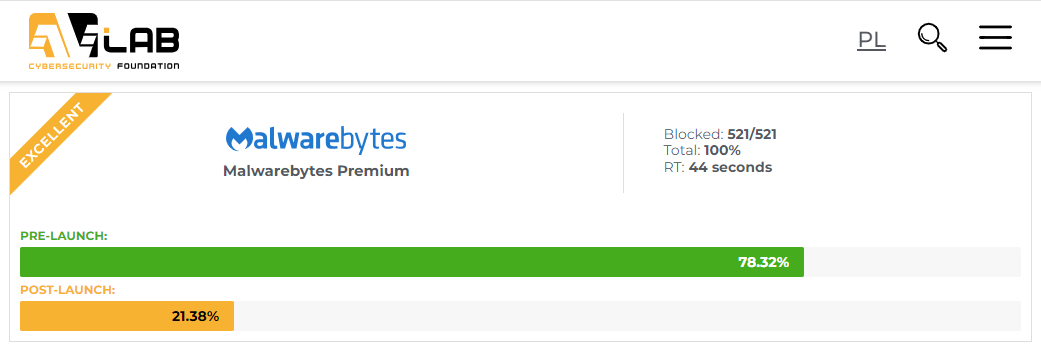
Image: Alaina Yee / Foundry
At a glance
Expert’s Rating
Pros
- Clean, simple interface
- Essential protection against malware
- Lower impact on PC system resources
Cons
- Less participation in testing performed by independent security organizations
- Extremely light on features
Our Verdict
Malwarebytes Premium Security offers a simple, easy-to-use alternative to Windows Security—but don’t expect big bang for your buck. Seasoned security vets may also find the lower amount of available independent performance test results offputting.
Price When Reviewed
60
Best Prices Today: Malwarebytes Premium Security
Malwarebytes was once a crucial piece of software—a necessary supplement for your main antivirus scanner. You couldn’t always count on just one program to catch everything, and Malwarebytes rose to prominence as a reliable secondary tool.
But the world has changed since 2010. Now if you run multiple antivirus apps, you could open yourself up to software conflicts or increased risk for system vulnerabilities. One single program is the way to go—and if you’re a newbie to security and prefer a dead simple app, then Malwarebytes’ streamlined, elegant approach can fit the bill.
How much does Malwarebytes Premium Security cost?
As a simple suite, Malwarebytes Premium Security costs $60 per year. New subscribers can sign up for a two-year package to save $9 ($111 total). Unlike most other antivirus vendors, Malwarebytes bills in monthly installments over a 12-month term, rather than charging the total cost upfront.
For its consumer products, the company offers a 14-day trial, and a 60-day money back guarantee.
Single-device plan (3 devices)
- $60 per year (billed monthly over a 12-month term)
Malwarebytes’ plan allows you to spread your device allotment over those running Windows, macOS, Android, iOS, and even ChromeOS.
If you want to cover more gear, or save a little more cash, you can get licenses for Malwarebytes through third-parties like Amazon and the PCWorld Software store with more flexible terms and at lower rates. However, such plans currently don’t include VPN service, which Malwarebytes added to the subscriptions it sells directly.
What does Malwarebytes Premium Security include?
When you step up from Malwarebytes’ free version to a paid subscription, real-time monitoring for malware, email, web, and select network threats becomes active. (The free plan only scans if you initiate a manual check.) Overall, you’re protected against viruses, ransomware, and other malware, as well as other common attacks like phishing attempts, zero-day exploits on the web and over email, and suspicious apps.
Choosing Malwarebytes Premium Security adds on access to the company’s VPN, which Malwarebytes advertises as a no-log service. As premium upgrades go, this one is simplistic—you don’t get parental controls, a password manager, additional defenses like protected folders, or PC utilities, as you do with a rival like AVG. The company seems to weigh its VPN service as equally valuable to a collection of such antivirus features.
Key features of Malwarebytes Premium Security
Installation and user interface
After you install the app, you’ll see the main dashboard. The interface is incredibly streamlined, with just two tabs on the left navbar—Dashboard and Settings. You can choose between Light, Dark, or matching Windows’ mode.
Accordingly, you’ll send almost all your time on the Dashboard view, which is divided into three segments. In the larger one, you’ll see a couple of sections blocked out. At the upper left is Security, with Scanner, Detection History, and Real-Time Protection as the three options and their settings:
- Scanner lets you run a quick, full, or custom scan, as well as jump directly to related settings. You can also access the scheduled scans to review what’s already set up and create new ones.
- Detection History shows quarantined items, the history of events (like detected viruses), and your allow list—items that you’ve approved as safe after initially being flagged by Malwarebytes.
- Real-Time Protection is not so much a feature, but an explanation for how Malwarebytes and how it safeguards your PC continuously.
Directly underneath the security section is one for the VPN. It puts the major controls at your fingertips, letting you quickly activate the service and change the location. You can also jump into related settings.
Along the right side is a rating for your PC’s protection level—Malwarebyte’s assessment of how close you are to utilizing the app fully. You can also check on other devices associated with your account.
Generally, the interface is clean and simple, as are the settings for the app and its features. The only area where you can dig in deeper are the antivirus protection settings—but as Malwarebytes rightly warns, nearly all users are better off leaving the defaults as they are.
One tip: Once the software is installed, head to Settings > Notifications, scroll down to the bottom, and turn off marketing notifications.
Virus, malware, and threat protection
Real-time protection
Malwarebytes Premium Security constantly keeps an eye out for a variety of threats. When you’re opening or adding files, using apps, or browsing the web, it’ll block viruses, ransomware, and other malware like rootkits, along with phishing attempts.
Unlike other rivals, Malwarebytes doesn’t offer a firewall. That job is left to Windows. It also doesn’t offer additional protections against dangers like DNS hijacking and webcam takeovers. As for identity protection, like dark web monitoring and insurance coverage, you must upgrade to the company’s Complete Protection plan, which costs twice as much per year.
If you want to adjust your real-time scanning settings, you can change what the app screens for and how stringent it is with its filters, as well as how it handles suspicious files. Malwarebytes allows you dig surprisingly deep, though only experts should get into the weeds. The overwhelming majority of users should keep the defaults as they are.
Scheduled and manual scans
At installation, Malwarebytes Premium Security automatically creates a scheduled scan for once per week. It runs whenever your system is idle, which the app calls a “smart scan.” You can edit this default or create additional scheduled scans.
For manual scans, Malwarebytes offers three types. The default is a threat scan, which checks commonly targeted areas of your PC, including things running in memory and at startup, as well as registry changes. Files stored on your PC are also looked over.
To fire up a quick or custom scan, you must choose Advanced Scan from the three-dot menu for the Scanner on the dashboard. Custom scans let you tweak a handful of settings related to file types and areas of your PC, as well as how to handle potentially unwanted programs and modifications to your system.
Additional features
Browser extension
Malwarebytes offers a Browser Guard extension for Chrome, Firefox, and Edge, but despite being available as a separate free download, it’s still considered a component of the Premium Security suite. After installation, it runs quietly in the background, protecting your browser from malware and scams (including credit card skimming), as well as serving as an adblocker.
VPN
Malwarebytes keeps its controls for its VPN simple rather than restrictive. Firing up the service is quick and fast, as is choosing a location for a server—and Malwarebytes lets you choose a handful of cities within countries outside of the US, more similar to a dedicated VPN.
You can choose servers in Albania, Australia, Austria, Belgium, Brazil, Bulgaria, Canada, Chile, Colombia, Croatia, Czech Republic, Denmark, Estonia, Finland, Germany, Greece, Hong Kong, Hungary, Indonesia, Ireland, Israel, Italy, Japan, Latvia, Mexico, Netherlands, New Zealand, Norway, Poland, Portugal, Romania, Serbia, Singapore, Slovakia, Slovenia, South Africa, Spain, Sweden, Switzerland, Thailand, UK, Ukraine, USA.
This country list isn’t as large as with some VPN services, but as mentioned above, you can generally choose between two to four cities per country. The exception is the United States, which has 18 cities available, coast to coast.
Speeds held stable when using the VPN during light testing. For US server speeds, Los Angeles (within the same state as PCWorld’s San Francisco location) showed a decrease of about 5 to 7 percent, while New York saw a roughly 26 percent drop.
Customer support
From within the app, you can jump to Malwarebytes’ user guide, support pages, and support tool. You can also use an AI chatbot for answers to your questions, or if you’re signed into your Malwarebytes account, to contact customer support—you’ll get funneled to your choice of email or live chat.
Updates and maintenance
Updates for the app and virus definitions happen automatically in the background, but you can also trigger a check manually. You’ll need to click on the person icon in the upper right of the app window, then choose About Malwarebytes and click on the Check for updates button.
Performance
While Malwarebytes participates in some independent benchmarking of its software, it has no current results from AV-Test and AV-Comparatives, two major organizations that test how well antivirus suites can catch threats.
Instead, the company points the curious toward AVLabs’s testing data. During the May 2024 advanced in-the-wild test, Malwarebytes caught all 521 samples—though its detection rate was split between 78.32 percent pre-launch and 21.38 percent post-launch of the samples (that is, before the malware samples could activate versus after). In comparison, rivals Bitdefender and McAfee caught nearly all the samples before they could execute, with 97.98 percent and 99.3 percent pre-launch detection, respectively.
When asked about its participation in independent benchmarks, a representative from Malwarebytes said the company “focuses on third-party testing that is most closely aligned with the needs of customers” and that it works “with the third-party testers that are most relevant to what our customers encounter in today’s threat landscape.”

PCWorld / AVLab
PCWorld / AVLab
PCWorld / AVLab
During hardware performance tests on our budget Acer Aspire 3 test laptop, Malwarebytes lived up to its claims of light impact on PC resources. When left idle in the background, it had virtually no effect on typical tasks, as shown by PCMark 10’s extended benchmark. That test simulates video chatting, web browsing, gaming, image and document editing in free apps like GIMP and LibreOffice, and the like.
If you work instead on Microsoft Office documents, our UL Procyon tests showed a minimal impact on results, with a less than 3 percent difference. Similarly, our Handbrake encoding test only dipped by about 4 percent.
Even running a threat scan continuously during our benchmarks didn’t disturb these numbers much—PCMark 10 slipped by about 7 percent, Procyon by about 14 percent, and Handbrake by about 19 percent. Given how rival antivirus engines from rivals like McAfee and Norton are far greedier about system resources, Malwarebytes does distinguish itself in this regard.
Conclusion
If you dislike complicated interfaces, Malwarebytes Premium Security can be a good fit as an alternative to Windows Security—so long as you don’t mind not getting as much bang for your buck. The app is attractive and clean in its layout, and the settings are clear and straightforward. However, more seasoned security vets may have reason to hesitate on pulling the trigger, due to the relatively low amount of independent testing data available about software performance.
Best Prices Today: Malwarebytes Premium Security
Author: Alaina Yee, Senior Editor, PCWorld

A 14-year veteran of technology and video games journalism, Alaina Yee covers a variety of topics for PCWorld. Since joining the team in 2016, she’s written about CPUs, Windows, PC building, Chrome, Raspberry Pi, and much more—while also serving as PCWorld’s resident bargain hunter (#slickdeals). Currently her focus is on security, helping people understand how best to protect themselves online. Her work has previously appeared in PC Gamer, IGN, Maximum PC, and Official Xbox Magazine.





